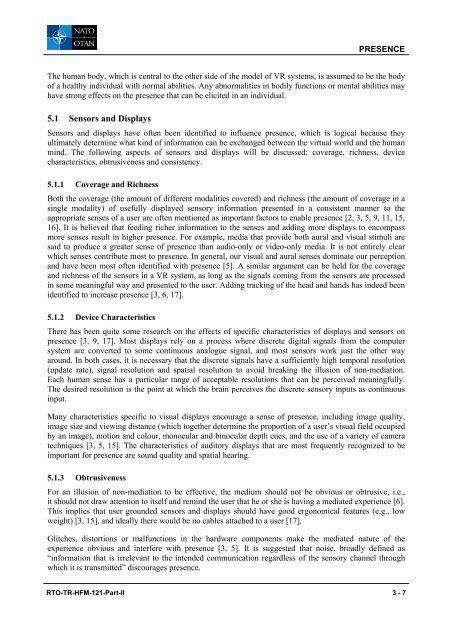RTO-TR-HFM-121-Part-II - FTP Directory Listing - NATO
RTO-TR-HFM-121-Part-II - FTP Directory Listing - NATO
RTO-TR-HFM-121-Part-II - FTP Directory Listing - NATO
You also want an ePaper? Increase the reach of your titles
YUMPU automatically turns print PDFs into web optimized ePapers that Google loves.
PRESENCE<br />
The human body, which is central to the other side of the model of VR systems, is assumed to be the body<br />
of a healthy individual with normal abilities. Any abnormalities in bodily functions or mental abilities may<br />
have strong effects on the presence that can be elicited in an individual.<br />
5.1 Sensors and Displays<br />
Sensors and displays have often been identified to influence presence, which is logical because they<br />
ultimately determine what kind of information can be exchanged between the virtual world and the human<br />
mind. The following aspects of sensors and displays will be discussed: coverage, richness, device<br />
characteristics, obtrusiveness and consistency.<br />
5.1.1 Coverage and Richness<br />
Both the coverage (the amount of different modalities covered) and richness (the amount of coverage in a<br />
single modality) of usefully displayed sensory information presented in a consistent manner to the<br />
appropriate senses of a user are often mentioned as important factors to enable presence [2, 3, 5, 9, 11, 15,<br />
16]. It is believed that feeding richer information to the senses and adding more displays to encompass<br />
more senses result in higher presence. For example, media that provide both aural and visual stimuli are<br />
said to produce a greater sense of presence than audio-only or video-only media. It is not entirely clear<br />
which senses contribute most to presence. In general, our visual and aural senses dominate our perception<br />
and have been most often identified with presence [5]. A similar argument can be held for the coverage<br />
and richness of the sensors in a VR system, as long as the signals coming from the sensors are processed<br />
in some meaningful way and presented to the user. Adding tracking of the head and hands has indeed been<br />
identified to increase presence [3, 6, 17].<br />
5.1.2 Device Characteristics<br />
There has been quite some research on the effects of specific characteristics of displays and sensors on<br />
presence [3, 9, 17]. Most displays rely on a process where discrete digital signals from the computer<br />
system are converted to some continuous analogue signal, and most sensors work just the other way<br />
around. In both cases, it is necessary that the discrete signals have a sufficiently high temporal resolution<br />
(update rate), signal resolution and spatial resolution to avoid breaking the illusion of non-mediation.<br />
Each human sense has a particular range of acceptable resolutions that can be perceived meaningfully.<br />
The desired resolution is the point at which the brain perceives the discrete sensory inputs as continuous<br />
input.<br />
Many characteristics specific to visual displays encourage a sense of presence, including image quality,<br />
image size and viewing distance (which together determine the proportion of a user’s visual field occupied<br />
by an image), motion and colour, monocular and binocular depth cues, and the use of a variety of camera<br />
techniques [3, 5, 15]. The characteristics of auditory displays that are most frequently recognized to be<br />
important for presence are sound quality and spatial hearing.<br />
5.1.3 Obtrusiveness<br />
For an illusion of non-mediation to be effective, the medium should not be obvious or obtrusive, i.e.,<br />
it should not draw attention to itself and remind the user that he or she is having a mediated experience [6].<br />
This implies that user grounded sensors and displays should have good ergonomical features (e.g., low<br />
weight) [3, 15], and ideally there would be no cables attached to a user [17].<br />
Glitches, distortions or malfunctions in the hardware components make the mediated nature of the<br />
experience obvious and interfere with presence [3, 5]. It is suggested that noise, broadly defined as<br />
“information that is irrelevant to the intended communication regardless of the sensory channel through<br />
which it is transmitted” discourages presence.<br />
<strong>RTO</strong>-<strong>TR</strong>-<strong>HFM</strong>-<strong>121</strong>-<strong>Part</strong>-<strong>II</strong> 3 - 7

















